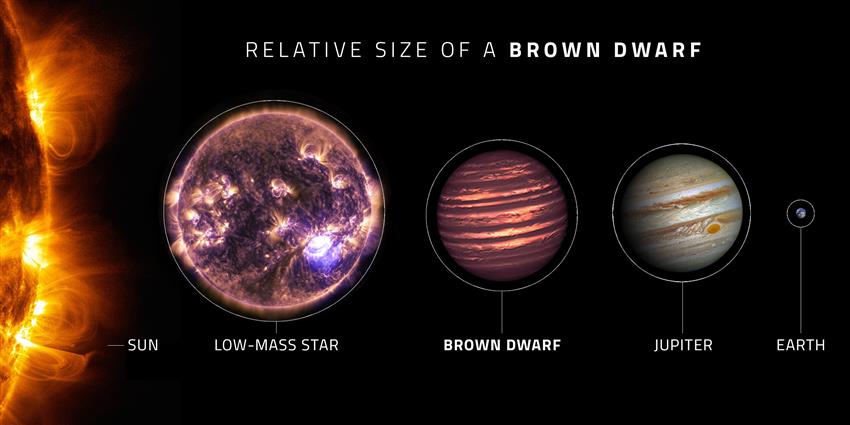Space oddities: brown dwarfs and rogue planets
Humans like to cleanly categorize the things around them: living or inanimate, plant or animal. But when it comes to astronomy, we quickly run into objects that defy our simple definitions.

An artist's illustration of a Jupiter-sized rogue planet that is freely floating through space and not orbiting a star. (Credit: NASA/JPL-Caltech)
Astronomers have come across many objects that are not easily classified, and these discoveries often lead to the creation of new categories of celestial objects. Sometimes, even relatively well-known objects are reclassified: for example, Pluto had been considered a planet since its discovery in . But in , it was re-categorized as a new type of object – dwarf planet. As astronomers continue to explore the cosmos, they encounter more objects that defy conventional classification and which must be further studied.
Rogue planets
A planet is defined as a round celestial body, orbiting a star, that has "cleared the neighbourhood of its orbit." This last part of the definition means that a planet must be the gravitationally dominant and clearly largest object along its orbit. But what happens if a planet breaks free from the gravitational pull of its star?
Planets are usually formed at the same time as their parent star in what is called a protoplanetary disc. Solar systems can be very chaotic, though, which can lead to a planet being completely ejected from its system! These rogue planets float freely through space without orbiting a star, and they are very hard to spot and study.
Brown dwarfs
A star is defined as a luminous sphere of hot gases (primarily hydrogen) massive enough to ignite the nuclear fusion of hydrogen inside its core. Planets, on the other hand, are not massive enough to have any nuclear fusion within their cores.
Some elements, such as deuterium (also known as heavy hydrogen), can be burned by nuclear fusion in celestial bodies that are less massive than the smallest stars.
Brown dwarfs lie between the definitions of planets and of stars. They are between 13 and 80 times more massive than Jupiter, and are therefore massive enough to fuse deuterium, but not hydrogen. In comparison, the Sun is about 1000 times more massive than Jupiter. Although brown dwarfs produce their own heat and energy, they shine much less brightly than stars, which makes them difficult to observe.
A Canadian look at these cosmic outliers

Researchers Dr. Aleks Scholz (University of St. Andrews, left) and Dr. Loïc Albert (Université de Montréal, right) are leading JWST GTO science programs that will help astronomers better understand rogue planets and brown dwarfs. (Credits: E. Broughton (University of St. Andrews)/L. Albert)
Rogue planets and brown dwarfs are both poorly understood, but Canadian astronomers slated to use the James Webb Space Telescope hope to change that!
Rogue planets and brown dwarfs are very hard to study because they are much less bright than stars, especially in the part of the light spectrum visible to humans. They are, however, quite a bit brighter in infrared light, which is the type of light the Webb Telescope has been made to observe. The Canadian instrument NIRISS on board Webb also has specific modes of observation that make it the perfect tool to study these mysterious objects. Through its participation in the Webb project, Canada has guaranteed access to 450 hours of telescope time during the first few years of the mission through the Guaranteed Time Observations (GTO) program.
Dr. Aleks Scholz of University of St. Andrews will be leading a GTO program that will use the NIRISS instrument for 19 hours to spot and study rogue planets and brown dwarfs in a nebula nearly 1000 light-years away. His team will be collecting spectra, or light broken down into its colours, from these objects to try to figure out how common they are. Dr. Scholz is also hoping to define clearer limits that will separate brown dwarfs from the largest planets and the smallest stars.
Dr. Loïc Albert (Université de Montréal), who is working on the previously mentioned program with Dr. Scholz, will also be leading a 3-hour-long GTO program to take images of brown dwarfs. Using NIRISS's interferometry mode, which will also be used to take pictures of solar systems being formed, Dr. Albert and his colleagues will try to observe some of the least massive brown dwarfs. This work will help astronomers determine how small brown dwarfs can get and will hopefully help them differentiate brown dwarfs from rogue planets, since these two objects share many similarities.
An international collaboration between NASA, the European Space Agency and the Canadian Space Agency, the James Webb Space Telescope is the most complex and powerful space telescope ever built. Canada contributed two key elements to Webb: the Fine Guidance Sensor (FGS) and the Near-Infrared Imager and Slitless Spectrograph (NIRISS). In exchange for that contribution, Canadian researchers will have access to 5% of the observing time available to the international community.
